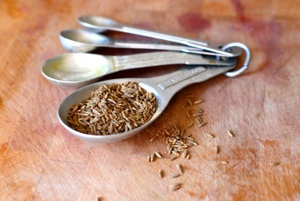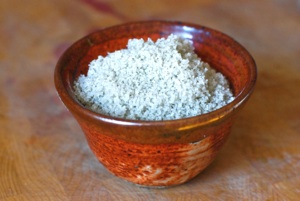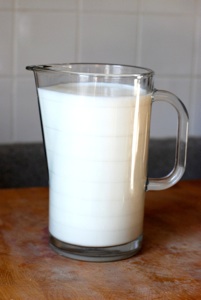One tomato, two tomato
I wish I had a cow. Then I could make cheese all the time with an endless supply of fresh milk. When I was a kid we had neighbors with a milk cow. If we wanted fresh milk we just stopped by the pump house along side the main road and picked up a couple of gallon jars. The first few glasses of milk were the best, since they were loaded with the cream from the top. That milk would have made dynamite cheese. When I retire, mark my words: I'm getting that cow. But since live in small house in Minneapolis, my Cumin Jack cheese will be decidedly urban, made with milk from my co-op.
Jack is a great cheese to make at home. It takes an afternoon and can be eaten in just a months time. While it takes several hours to make, the actual work is pretty minimal. You don’t need a cheese press as the weight applied to the cheese is very light. The finished cheese is waxed and aged for one to four months, depending on the desired sharpness. When made with whole milk, Jack is a semi-soft cheese. This version is spiced with cumin seeds and smoked paprika. My goal was to create a creamy melting cheese laced with earthy, smokey flavors that would be perfect on a cheese board, tacos or in fondue.
Cumin Jack Cheese
1/11/13
A chronicle of my adventures growing, preserving, cooking and eating from my garden and everywhere.

Known to many for my incredible ability to organize, I tackle gardening and life with equal verve. Obsessive, is that a bad thing?
Cumin Jack Cheese Recipe
By Tammy Kimbler
Adapted from Home Cheese Making by Ricki Carroll
Ingredients:
1 gal whole milk
1 package direct-set thermophilic starter*
1/2 tsp liquid rennet* diluted in 1/4 c water
1/4 tsp calcium chloride* (unless you’re using raw milk) diluted in 1/4 c water
1 tbs kosher salt
1.5 tsp cumin seeds
1.5 tbs smoked paprika
Equipment:
2 gal pot with lid
thermometer
long stainless steel spoon
long stainless steel knife or cake spatula (for cutting curds)
ladle
colander
cheese cloth*
cheese mold & followers (if using)*
cheese mat* or sushi mat
cheese press*
cheese wax*
*Ingredients and equipment were ordered from New England Cheesemaking Supply Company, Hoegger Supply Company and Northern Brewer.
(If you've never made cheese before, check out this beginning cheese maker's guide at Cheesemaking.com.)
Instructions:
Begin by sterilizing your cheese making equipment, either by boiling it for 10 minutes in water or by washing in hot soapy water and rinsing in Star San* (a sulfide based sanitizer used in beer making.)
Take your cumin seeds and pour 1/4 cup boiling water over them. Allow them to soak while you heat the milk. Strain the seeds from the liquid and reserve both liquid and seeds separately.
Heat the milk in your sterile pot to 100 degrees. I do this by submerging the pot in a sink full of hot water to bring it up to temperature. Add the thermophilic starter and stir well. Check your water and milk temp to make sure they are at 100. Cover the pot with a lid and then cover the sink/pot combo with a thick bath towel to insulate it. Allow the milk to culture for 30 minutes.
Add the diluted calcium chloride and cumin soaking liquid, and mix well. Then add the diluted rennet, stirring gently in an up and down motion. This is to distribute both the rennet and any separated cream in the milk. Check that the temp is at 100 degrees and cover again with the lid and towel for 40 minutes until the curd sets.
Check that your curd has set. It should have the consistency of Jello. When you cut it, the pieces should separate cleanly and not blend back together like yogurt. Just cut a little corner and see if it cuts cleanly. If not, let it sit another 5 minutes.
Cut the curds into 1/4 inch cubes with your long knife. Make a grid pattern that goes all the way to the bottom and sides of the pot, like tic tack toe. Now angle your knife cut diagonally, ending in the side of the pot, going all the way down to the bottom. Give the pot a quarter turn and do it again. Don't worry about doing it perfectly. You're just trying to cut the curd into small distinct pieces. Let the curds rest for 10 minutes.
Heat the curds to 110 degrees by removing half of your water from the sink and replacing it with hot water. This may take upwards of 30 minutes for the milk to raise in temp. This is good. It's fine to go slow because you're giving the curds a chance to loose whey. If you go to fast they won't expel the whey properly. During this process gently stir the curds to keep them from sticking. They will loose whey as you go.
Maintain the temp at 110 degrees for another 30 minutes, stirring the curds every 5 minutes or so to keep them from matting. Now let the curds rest for 5 minutes.
Carefully ladle off the excess whey until the level is right above the curds. Keep the whey for pancakes, soup stock or for your pets. They love the stuff. Let the curds sit for 30 minutes more, continuing to stir every 5 minutes.
Line a colander with doubled up cheese cloth. Gently ladle curds into the colander to drain. Sprinkle with salt and reserved cumin seeds. Gently mix the curds with clean hands to distribute the salt and seeds. If using a cheese press, line the press with cheese cloth. Spoon the curds into the mold, fold over the cheese cloth, add the followers and assemble your cheese press.
If not using a mold, simply tie up the cheese cloth in your colander until snuggly surrounding your curds, tying the top with butcher's twine so no curds escape. Place bundle on a cheese mat set on a tray to catch the liquid. Place a plate on top of the curds.
Place a 1 lb weight on the curds for 30 minutes. A pint jar of water works great. Remove cheese from mold, remove cloth, flip over and redress with cheese cloth and add back to the mold. If not using a mold, remove the cheese from the cheese cloth and flip, then redress snuggly with cheese cloth, tie and add the plate back on top.
Place 8 lb weight on the cheese over night. A gallon of water in a milk jug will work if you don't have a cheese press. The next day un-mold and unwrap your cheese. Sprinkle all sides with smoked paprika, rubbing with your fingers to distribute. Place on a clean cheese mat to dry. Flip the cheese twice a day day until no more moisture exudes from the bottom sides. It should take a couple of days.
When the cheese is dry, it's time to wax the cheese. Melt the cheese wax in an old reusable pan or bowl set over a double boiler. You want the wax to reach at least 200 degrees. Wax can ignite at high temps so please do not leave unattended. Set your cheese on a sheet of wax paper. Brush the was in a thin layer over all sides with a natural bristle brush (nylon will melt). Let set for a moment, then brush again. Try to fill all the air bubbles. You're trying prevent air pockets where mold can form.
Once your was has set, store your cheese at 55 degrees for one to four months. I store mine in a wine fridge, but a cool basement would also work well. I plan on cutting my wheel in half at two months, consuming one half, then re-waxing the other half to age for two more months. Please note that if you are using raw milk you should age it for at least 60 days, which gives the cheese enough time to develop acid that will kill any milk born pathogens.






All content on this website is copyright Tammy Kimbler, unless otherwise noted. All rights reserved.




